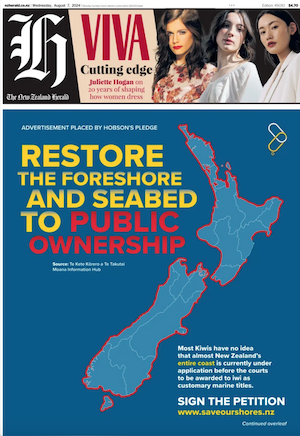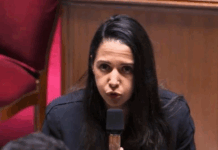
COMMENTARY: By Gavin Ellis
The New Zealand Herald and its publisher are failing to follow a golden rule: Engage with readers when they question your actions.
The Herald is currently confronted by two controversies. The first is its decision to use artificial intelligence to write editorials. The second is its decision to publish a highly divisive advertising wrap-around paid for by the lobby group Hobson’s Pledge.
In neither case has the newspaper or its owner NZME offered an explanation that justifies its decisions. Indeed, it has given little insight into what its decision-making processes were on either matter.
- READ MORE: AI-created editorials: What in HAL’s name was The Herald thinking?
- Hobson’s Pledge front page ad is propaganda disguised as news — Shilo Kino
Following RNZ’s revelations over The Herald’s use of iterative AI to write editorials, The Herald’s reaction was to simply say it did not apply sufficient “journalistic rigour” and that it would be calling a meeting of all editorial staff to discuss AI policy.
This commentary last week posed a series of questions relating to the processes that went into the publication of those editorials. If they were answered at the staff meeting, neither I nor The Herald’s other readers are any the wiser.
Staff were left in absolutely no doubt that what went on at that meeting was confidential and Herald staff I have spoken to have scrupulously observed that obligation not to disclose what occurred. NZME declined to comment to other media that enquired about the meeting (the fact it was taking place had been publicly disclosed).
Instead, several days later the company used its customary conduit, editor-at-large Shayne Currie’s Media Insider column, to ensure the narrative remained positive.
Review of protocols
Currie disclosed some of what was discussed at the meeting (I guess he had a waiver on confidentiality) and said The Herald “will review and further tighten artificial intelligence protocols”. He did not, however disclose the mood of the newsroom in reaction to the news that editorials had been written by AI, choosing instead to merely report editor-in-chief Murray Kirkness “addressing concerns from staff”.
Kirkness apparently told the meeting critical issues were “the level of human oversight, that the publication was transparent with readers, and that policies were continually reviewed and updated”.

None of that told readers how or why the editorials came to be robotically written in the first place, nor why the publication had failed to be transparent with readers. It certainly did not reveal whether the editor-in-chief had been taken to task by staff who, in private correspondence before the meeting, had expressed their dismay.
The Herald’s current statement on its use of artificial intelligence includes no requirement for public disclosure of its use on any story. The only requirement for disclosure is when AI generated images are used on features or opinion pieces: “When we do this, we will acknowledge this in the image caption or credit.”
I get the impression all other use of AI by The Herald is covered by its general statement that, yes, it does employ artificial intelligence. That disclosure is in a statement that you will find at the very bottom of The Herald website. You’ll find it here.
Initially I went looking for it on the mobile app, then the app on my iPad. I gave up. I assume it’s there somewhere.
NZME is doing the right thing by reviewing its policy, but it should not wait until that review is completed — and the current AI statement on the website presumably replaced — before offering adequate explanations and assurances to its readers.
Fundamental principles
There are fundamental principles here that do not require prolonged analysis. Editorials are the opinion of the newspaper — not iterative content — and must be written by designated staff overseen by the most senior editor on duty. Transparency is paramount and stories created by artificial intelligence should carry a disclosure, just as stories from non-Herald sources carry a credit line.
Stuff’s Code of Practice is clear: “Any content (written, visual or audio) generated or substantially generated using generative AI will be transparently labelled outlining the nature of AI use, including the tool used.” It should be clear, too, to The Herald and its readers.
Assurances can and should be given now.
The Hobson’s Pledge advertisement that wrapped last Wednesday’s Herald is a different issue but, again, one the publisher has not handled well. It followed a government announcement that it disagrees with the Court of Appeal’s interpretation in a case defining the customary interests of iwi in the eastern Bay of Plenty, and it intends to change the Marine and Coastal Areas Act to set the bar higher for claims. The advertisement painted a picture of wholesale Māori “ownership” of the foreshore if the law did not change.
The Herald was immediately condemned for publishing the wrap-around, with Māori journalists expressing “profound shock and dismay”, Te Pāti Māori saying it “will no longer engage” with the newspaper, and social media posts calling for boycott.
The response from NZME was a statement that the company was “keenly aware of its obligations as a publisher and broadcaster, including in respect of legislation and Advertising Standards Authority (ASA) codes”.
“Advertising responsibility sits with NZME’s commercial team and is separate to NZ Herald editorial.
“The content is a paid ad from an independent advertiser and is clearly labelled as so.
“There are thousands of ads placed across our platforms every week and publishing an ad is in no way NZME’s endorsement of the advertised message, products, services or other.
“We’re reviewing our processes and policies around advocacy advertising.”
Answer to obvious questions?
All true (although in my day as editor I had responsibility for all published content), but that does not answer some obvious questions, the most important of which is whether it passed tests devised to deal with the thorny issue of advocacy advertising.
Last night The Herald announced — again through Shayne Currie — that it had rejected a second advocacy advertisement that Hobson’s Pledge had tried to place with the newspaper. As to why, it again said no more than “we are reviewing our policies and processes”. There was no expression of the reasons, in the meantime, the ad had been rejected.
The right to free expression is guaranteed by the Bill of Rights Act. That right, however, is not unlimited and judgment needs to be exercised in determining the boundaries in individual cases.
The Advertising Standards Authority has acknowledged advocacy advertising presents some of the greatest challenges facing its complaints procedures. Before they reach the complaints stage (and the Hobson’s Pledge advertisement is apparently the subject of a number already), the same challenges face the publications asked to publish them.
For that reason, the ASA has issued a fulsome guidance note on advocacy advertising. You can read the guidance here.
This was a wrap-around of The Herald, meaning that, although it was clearly labelled as a paid advertisement, it sat directly beneath the paper’s own masthead, which is more significant than if it had been carried on an inside page. The connection with the masthead means even greater care needs to be taken by the publisher in determining whether to accept the advertisement for publication or not.
The question NZME has yet to answer is whether it subjected the material to all of the tests set out in the ASA guidance note. If it did so and all the tests were passed by the first advertisement, there is a compelling free speech argument for its publication.
Disclosure statement
A decision to publish in such circumstances would benefit immensely from a disclosure statement from the editor (the custodian of the masthead) attesting to all of the steps that had been taken in judging fitness for publication. Similarly, readers should be informed whether the same tests had been applied in rejecting a second advertisement and how it differed from the one judged fit for publication.
The guidance note sets out a list of points against which an advocacy advertisement should be weighed:
- It must be clearly identified as an advertisement
- It must clearly state the identity and position of the advertiser
- Opinion must be clearly distinguishable from factual information
- Factual information must be able to be substantiated
- Any combination of opinion and fact must be justifiable
- It must not contain anything that is indecent, or exploitative, or degrading or likely to cause harm, or serious or widespread offence, or give rise to hostility, contempt, abuse, or ridicule
- Heed must be taken of the likely consumer takeout of the advertisement (in other words, whether there is there a contextual justification)
The guidelines also deal with the weight given to academic studies, the status of the organisation placing the advocacy advertisement, and the use of such advertising by official bodies.
I am making no judgement on the Hobson’s Pledge advertisements. If the first had been subjected to those tests by The Herald and had satisfactorily passed each of them, NZME could (and should) have informed readers of the fact.
If the advertisement had failed any of the tests, the company would have had legitimate and defensible reasons for rejecting it. It presumably has those solid grounds for rejecting the second advertisement.
Obviously contentious
The published wrap-around’s subject matter was so obviously contentious that The Herald should have gone to some lengths in the same edition to explain its decision to run it. Assuming the application of the ASA guidelines determined that it could be published, readers should have been informed of that fact.
Instead, they were given a bland statement of NZME’s awareness of standards, and little more in the announcement of the rejection of the second.
Given the likelihood of adverse reaction from some quarters to publication, the first advertisement should also have been a statement from the publisher justifying publication, perhaps as a matter of free expression in which all sides of an issue should be allowed to be aired because, in the words of John Milton’s Areopagitica, “in a free and open encounter” truth would prevail.
Similarly, last night it should have explained why the second iteration should not be subjected to that “free and open encounter”. In doing so, it might have invoked Stanley Fish’s essay There’s no such thing as free speech, and it’s a good thing, too in which he discusses the way in which free speech is, in fact, a space we carve out. It acknowledges that some forms of speech “will be heard as (quite literally) intolerable” and sit outside that space.
Dr Gavin Ellis holds a PhD in political studies. He is a media consultant and researcher. A former editor-in-chief of The New Zealand Herald, he has a background in journalism and communications — covering both editorial and management roles — that spans more than half a century. Dr Ellis publishes the website knightlyviews.com where this commentary was first published and it is republished by Asia Pacific Report with permission.













































